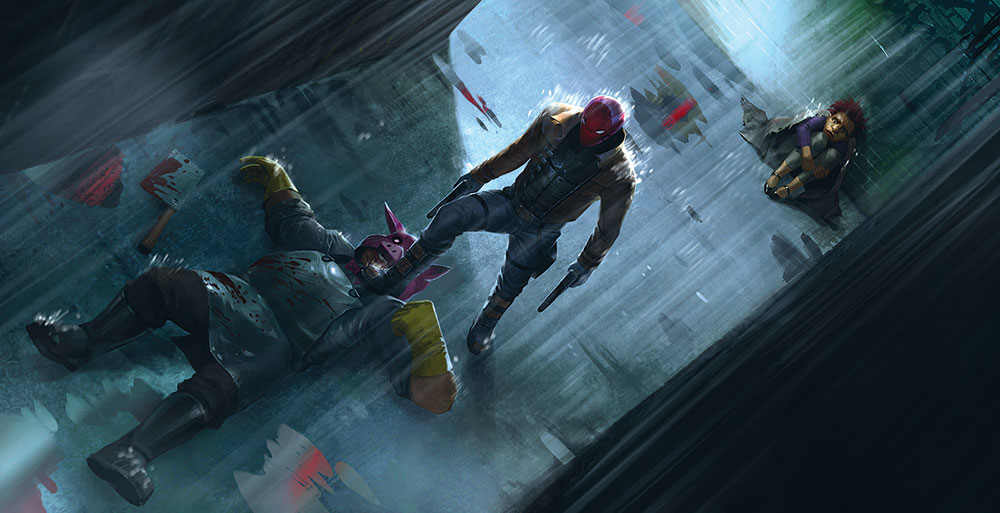Art Critiques Work Only for Pieces Created After 1400
How to give and get more from fine art critiques
One of the about important means to better as an artist is past having your work critiqued. Sometimes y'all have no choice: every bit a student, you're critiqued by your tutor; equally an employee, past your creative director. At other times, you'll seek out a critique. Either way, it's a bang-up way to become insight into how to better.
In that location's only 1 problem. We're all human and no ane likes to exist criticised. "Working every bit an illustrator and concept creative person, you e'er dread the moment where you show the piece of work," admits Loïc Zimmermann, who's an art manager at MPC and a teacher at Gnomon. "We all want the tap on the back."
- 7 biggest illustration trends of 2018
Simply hiding would exist a big mistake. "Peer feedback for both personal and professional work is invaluable, because everyone loses perspective on their own work – both in full general and on each piece as they work on it," says Drew Whitmore, a chief artist at Atomhawk. "Getting that outside context gives you a route to seeing your work with clearer eyes."
Loïc agrees. "Learning to accept criticism will make you a better creative person; you but have to larn not to take information technology personally," he stresses. "Nobody's going to hire someone who throws a tantrum each fourth dimension points are raised, however talented they are."

So what can yous to do if critiques make you lot overemotional? In that case, you actually need to get critiqued more oftentimes, Drew suggests. "If you're too precious most your artwork and don't get a lot of feedback, that feedback is going to hurt if it's something you feel strongly most," he reasons. "Yous have to build up those calluses."
Run into the crit for what it is
It's also of import to take a step back and empathise with the person giving the critique. "Getting a rough crit can feel like a personal attack, simply considering you lot'd put so much of your time, energy, and emotion into creating the work," says Us artist Daniel Warren.
"But if someone cares enough to give you a well thought-out critique in the first place, then it means they're invested in your improvement and care enough to assistance y'all grow. So see this for what it is: help from a person who'south probably dealing with the same things that you are."
In short, while a critique can frequently experience like criticism, they're not the aforementioned thing. Criticism is often purely based on subjective, personal opinion – whether someone likes your work or non. In contrast, a critique should be purely objective and address one central question: does the piece achieve what the creative person has gear up out to create?
"Lots of artists tend to mix upward criticism with an opinion on the quality of their piece of work and their value as an artist," says French art director and freelancer Pascal Blanché. "But a critique isn't almost you. It'southward a process that aims to improve the final version of your fine art. In one case y'all recognise this, you can start to assistance and guide the person who is critiquing your work by discussing the issue and keeping an open listen."

And note that 'discussing' doesn't mean 'arguing': this is not a naught-sum fence, but a process of constructive dialogue. That's the spirit in which Sarah Robinson, creative director for Paizo in Seattle, approaches receiving a critique.
"I usually let them happen calmly," she says. "I may non concur with them, but in that case I'll just get ahead and make the requested changes to let them see how it would look, and explain to them why it wouldn't work."
Above all, you should never feel singled out, considering receiving a critique is something every artist has to become through. "All visual medium is open for criticism," Sarah stresses. "It's going to happen, so if you can't take it and so mayhap you're in the incorrect business." And the pay-off is that y'all can use the feedback positively, to meliorate your art.
Jumping board
How you exercise that will vary in different situations, says Drew. "But generally, you can either implement the suggestions, or use their critique as a jumping board for being analytical nigh your image," he says.
"Fifty-fifty if there are bits of a critique that I don't agree with, in that location's probably all the same something at that place to resolve. Then I try to see if there are other routes to solving those bug, other than the suggested one, that will nonetheless retain what I liked previously."

Near importantly, never stop asking for critiques, because without them, your art is probable to stagnate, says Loïc. "I've done this task long enough that I have passionate people coming in, fresh out of school, who bring together and slowly fade over the years," he says.
"It seems like at that place's a layer of grit on them, and the flame, the burn in the eyes, just fades. And this is why y'all need to keep a critical thinking on your ain work, and prove it to the people who'll assistance you lot become better."
And there's no such thing as an creative person who's likewise successful to enquire for a critique. "Some of the best people I know ask for opinions," Loïc points out. "Yous wouldn't wait Jeremy Mann to tell you lot, 'Hey, what do you call back of that painting?', but he does, because he's curious. The most established people, the strongest ones, withal desire to know."
Giving something back
Likewise every bit receiving critiques, as a professional person creative person you're oft asked to critique other artists' piece of work. But as we've already noted, no one likes hearing negative views of their art. So how do you go about it?
While affairs is central, soft-soaping the truth is not an option, says Sarah Robinson, who regularly reviews other artists' piece of work at conventions. "Hearing the truth is what helps," she points out. "We all want to become improve, and if we're told that we're crawly all the time, and then there's no gamble of going to the side by side level."

Dave Rapoza, an creative person for games and films who's only launched his ain comic entitled Steve Lichman, agrees. "You don't do anyone a service by holding back," he says. "People are looking for someone to exist honest. Remember, they're asking for critique. If they want compliments instead, they need to make that articulate."
Neither, though, should you only spit out your own personal views of the work, says Loïc Zimmermann. "It's not about you and whether you like the art or not. That's not relevant," he explains. "Information technology'due south about what is the artist trying to do, and how well they're working towards that goal."
"A critique requires you to do more than just await at the art; it's about agreement the ambitions backside it," agrees American creative person Daniel Warren, who's recently been working with Dave Rapoza on Steve Lichman. Daniel used to critique artists regularly online via Livestream and Twitch, and even so does so for those who reach out via email.
"I typically try to first place what field they're trying to get into," he explains. "Concept art? Book analogy? Comics? And then I frame the crit around the needs and requirements of getting into that field."
This way, there's a better chance of your critique hitting home, he adds. "It shows them that yous actually took the time to notice their work and aren't simply giving them the boilerplate responses yous give to everyone who asks for help."
Give yourself fourth dimension to reply
Drew Whitmore agrees that taking your time is key. "Don't immediately jump into critique," he advises. "Looking at their image a couple of times, with some time in between, gives you a better view of what the issues are," he advises. And try to exist constructive rather than just narrowly critical.
"Always try to take a proposed solution," Drew stresses. "Point out what y'all think is incorrect and why, and then what you recollect they should exercise about information technology. If you don't have a solution off-hand, it'due south adept to hash out it with the artist, and inquire them a bunch of questions. Often, they'll think of a good solution themselves."

To brand sure you don't slide too far into negativity, Daniel recommends the 'crit sandwich'. "The formula is 'positive, negative, positive'," he explains. "Information technology's very important to remember that critique is not just negatives. Identifying what works, and the strengths, is equally of import.
So, for every two areas of weakness, endeavor to find an area of strength. For case: 'The anatomy could employ some work; specifically the proportions in the arms. The costume design is really great, though – information technology'due south unique and makes the character pop. Maybe bump upwards the lighting so that it showcases the outfit more.'"
Agreeing on crit limits
Loïc adds that it's important from the showtime to clarify with the artist exactly how open up they are to criticism of their work. "So I usually inquire: 'How far exercise yous want me to become? Are you done with information technology and are asking politely, but ultimately yous don't want to change a thing? Or this is something that you really want to improve?' I recollect that'south a expert place to start."
Bear in mind that there's no 'right' answer here: yours is a second opinion, not the be-all and cease-all. "Apart from the low-hanging fruit around fundamentals, such as perspective, anatomy and lighting, a lot of stuff is very subjective," points out Drew. "With client work it gets easier because, hopefully, at that place's a clear management coming from the client.
"With personal work, though, you demand to consider where the creative person is wanting to go. You tin can refer to other creatives who are successful at the matter this particular artist is trying to do as a jumping lath for your feedback, so they know y'all're not trying to accept them some identify they don't want to go."
Think big, not minor
Information technology's of import, too, to non go bogged down in details, says Daniel. "Stick to the three main problems you see in the work rather than overwhelm the person with every little matter y'all believe is wrong," he advises. "This serves to make the artist yous're critiquing focus on the big, of import problems and keeps them focused."

Above all, recall y'all're talking to a human being, so address them in the aforementioned friendly way yous'd similar to be addressed yourself. "It's not just about what you lot say, but how you say it," says Dave. "The important thing is to convey why something isn't working and how to better it; yous don't have to be nasty about information technology. Information technology'south basically rest betwixt the two people; both need to be sensitive to each other."
And Loïc is a slap-up believer in a lightness of touch. "I think sense of humour is something that works for everything in life," he says. "I outset my class with anecdotes every time; it'due south like a mode in. And you have to talk passionately near the skillful stuff. Then it's easier to say to them: 'Then hither, why did y'all screw it upwardly? These parts are a very interesting direction, merely you demand to follow it the entire way through.'"
This article was originally published in issues 155 and 156 of ImagineFX , the world's best-selling magazine for digital artists. Subscribe to ImagineFX hither .
Related manufactures:
- 10 hottest illustrators of 2017
- Concept design tips for artists
- Why you should take an art class online
Related articles
Source: https://www.creativebloq.com/features/how-to-give-and-get-more-from-art-critiques
0 Response to "Art Critiques Work Only for Pieces Created After 1400"
Enregistrer un commentaire